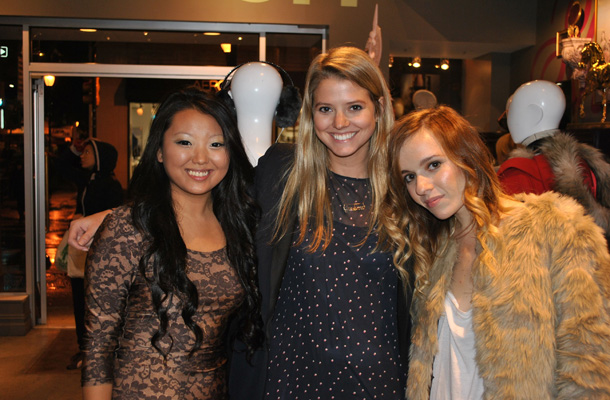
Websites such as College Fashionista make up-and-coming trends accessible to young fashionistas and fashionistos.
In the past, people glossed through major magazines like “Vogue” or “Harper’s BAZAAR” for the latest fashion trends worn by picture-perfect models, but not Generation Y. They grab a smart phone and check the blogosphere to see what real people are wearing. College Fashionista, one of the latest fashion blogs, consists of a series of on-the-spot interviews profiling stylish people on more than 200 college campuses nationwide.
Juicy Couture at 17th and Walnut streets hosted a College Fashionista meet-and-greet on Thursday, Oct. 27, so readers could meet the contributors from the universities in Philadelphia as well as Amy Levin, the blog’s founder.
She said the idea to showcase street style came to her after studying abroad in London, and she started the blog during her senior year at Indiana University.
“I loved the idea of taking photos on the street and using them as an inspiration for what real people were wearing, and what trends were happening,” Levin said.
Initially, Levin was the sole writer and the blog only covered Indiana University. After she graduated, she expanded her blog by starting a website that covered five college campuses. Now, College Fashionista currently covers more than 200 campuses in 14 countries.
Each campus has its own Style Gurus who are constantly on the prowl for new fashion trends. When a style guru encounters a dapper man or an elegant dame, they spring into action. Upon introducing themselves, the gurus photograph their fashionista and write a short rundown of the trends people are wearing on campus.
According to the website, contributors emphasize certain aspects of fashion depending on the day of the post. Monday is supposed to highlight ways to work different trends into wardrobes. Tuesday is all about men’s fashion. On Wednesday, the bloggers select a student to discuss their opinion on current trends. Thursday is all about beauty techniques straight from the runway. Contributors discuss accessories and fashion overseas on Friday.
While the Temple College Fashionista page isn’t updated daily, Hannah Ryan, a style contributor, still tries to make fashion accessible to her readers. In describing what her fashionista is wearing, Ryan links readers to stores that sell pieces similar to those found on her fashionable showcased Temple student. Readers see what trends are out there, and also see where to get everything. College Fashionista is all about making fashion easily accessible to all readers.
Nicole Geist, a senior biology major, uses College Fashionista to diversify her wardrobe.
“I see what [trend] they have for the day, and I see if I have it,” Geist said. “If I don’t, maybe I should get it so I can change [my wardrobe] up.”
She added she has gone to stores with College Fashionista trends in mind because she sees how they look on real people in everyday life.
Since College Fashionista covers a wide span of campuses, readers from one college can see what trends are going on at schools across the city or across the world.
Much like Geist, Ryan said she checks the blogs frequently so she can keep up with what fashion trends are going around, and how to correctly wear them.
“I read about combat boots, and I realized, ‘Wow, I can rock them,’” Ryan said.
Vogue showcases fashion as if it’s in a perfectly controlled environment, but street style shows how fashion trends are worn in practical, everyday ways on a realistic budget. A single couture outfit could cost tens of thousands of dollars, which is more than some students pay for a semester’s tuition. In light of the recession on a college budget, students must save money in lieu of excessively spending on designer clothing.
Levin said he found Generation Y does not care about name brands as much as the way outfit pieces look together.
“I’ll interview people and they’ll point to different pieces of their outfit and say this is vintage, this is Wal-Mart and this is H&M,” Levin said.
Urban fashion forward college students get creative with their shopping habits because they can easily access a wide variety of clothing boutiques, she added.
Being a New York City native, Ryan said she feels her compulsion to be knowledgable of the latest fashion stems from living in an urban environment.
“There are so many great boutiques in Philly, and there’s a lot more style diversity [on colleges in the city],” Ryan said.
Levin said she also noticed how students living in major cities are very concerned with their fashion as opposed to suburban or rural campus students.
“There [are] definitely differences, there’s so much diversity [on urban campuses]. City based schools are more sophisticated–they’re clumped in with real people. It’s not that college atmosphere where you can throw on sweats,” Lein said. “There’s a lot more emphasis on what you’re wearing to class, because everyone’s looking at the blogs. They’ve inspired people.”
Ryan said she sees many trends on College Fashionista she integrates into her personal style repoitere.
Fashion is a way to show people something about yourself upon first glance, and it gives people the freedom to be anyone they want, she added.
“Fashion is staying true to yourself while incorporating trends,” Ryan said. “No one can tell you you can’t wear that.”
Mark Longacre can be reached at mark.longacre@temple.edu.


nice review man.. i think i would post this kind of post at my blog http://fashioninstitutes.org
THANKS!